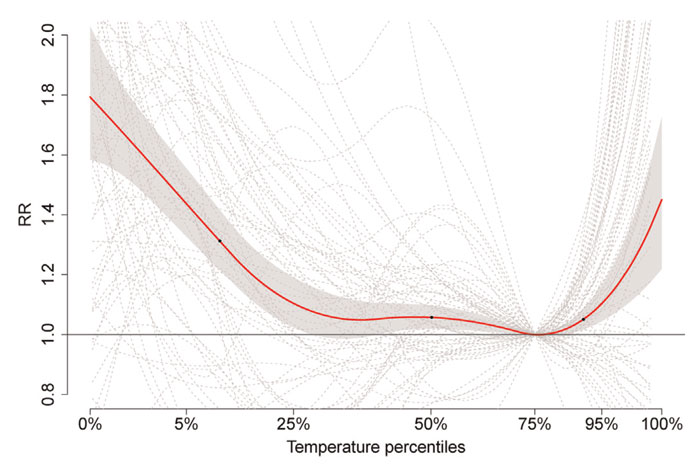| Tweet | Follow @co2science |
Paper Reviewed
Ma, W., Wang, L., Lin, H., Liu, T., Zhang, Y., Rutherford, S., Luo, Y., Zeng, W., Zhang, Y., Wang, X., Gu, X., Chu, C., Xiao, J. and Zhou, M. 2015. The temperature-mortality relationship in China: An analysis from 66 Chinese communities. Environmental Research 137: 72-77.
In a study published in Environmental Research, Ma et al. (2015) used a Distributed Lag Non-linear Model (DLNM) to determine the community-specific effects of extreme hot and cold temperatures on non-accidental mortality during 2006-2011 in 66 different Chinese cities, after which they conducted a multivariate meta-analysis that enabled them to pool the individual estimates of community-specific effects.
These efforts led to the U-shaped relationship depicted in the figure below for the nation as a whole, which shows that both daily maximum and minimum temperatures were associated with increased mortality risk compared to that of the overall mean temperature, but that the relative risk (RR) at the mean daily minimum temperature was significantly greater than that at the mean daily maximum temperature.

Pooled overall temperature-mortality response curve based on 66 communities across China.(The percentiles on the x-axis correspond to the average distribution of temperature across all communities; reference to 75th percentile of community-specific temperature distribution; natural cubic splines with 5 degrees of freedom, knots at 10th-50th-90th percentiles of temperature).
And so we see that typically-experienced extreme cold throughout China is much more deadly than is typically-experienced extreme heat, which finding, in the words of the 14 researchers, "is consistent with previous studies," as demonstrated by the earlier analyses of Guo et al. (2011), Guo et al. (2013), Chen et al. (2013), Wu et al. (2013) and Xie et al. (2013).
References
Chen, R., Wang, C., Meng, X., Chen, H., Thach, T.Q., Wong, C.-M. and Kan, H. 2013. Both low and high temperature may increase the risk of stroke mortality. Neurology 81: 1064-1070.
Guo, Y., Barnett, A.G., Pan, X., Yu, W. and Tong, G. 2011. The impact of temperature on mortality in Tianjin, China: a case-crossover design with a distributed lag nonlinear model. Environmental Health Perspect 119: 1719-1725.
Guo, Y., Li, S., Zhang, Y., Armstrong, B., Jaakkola, J.J.K., Tong, S.,K. and Pan, X. 2013. Extremely cold and hot temperatures increase the risk of ischaemic heart disease mortality: epidemiological evidence from China. Heart 99: 195-203.
Wu, W., Xiao, Y., Li, G., Zeng, W., Lin, H. and Rutherford, S. 2013. Temperature-mortality relationship in four subtropical Chinese cities: a time-series study using a distributed lag non-linear model. Science of the Total Environment 449: 355-362.
Xie, H., Yao, Z., 2013. Short-term effects of the 2008 cold spell on mortality in three subtropical cities in Guangdong province, China. Environmental Health Perspectives 121: 210-216.
Posted 23 June 2015



